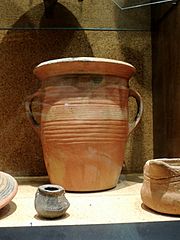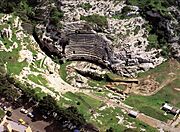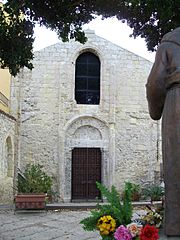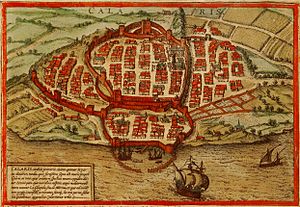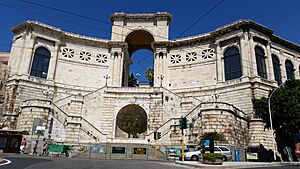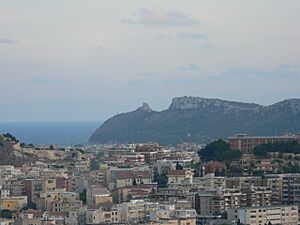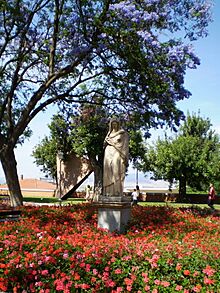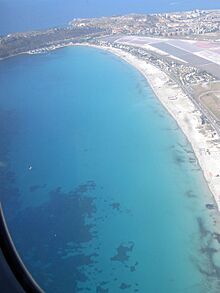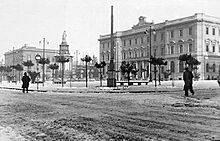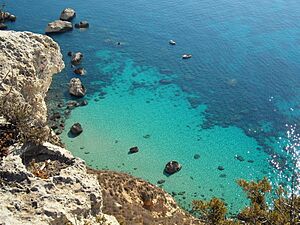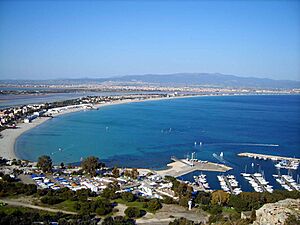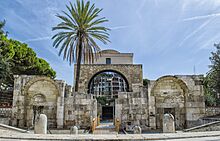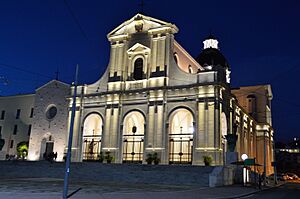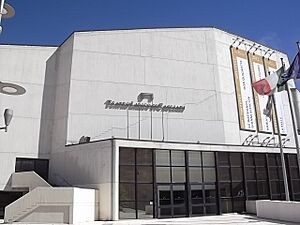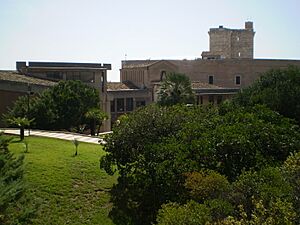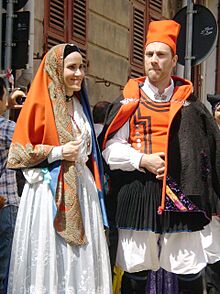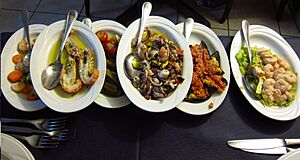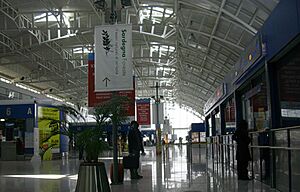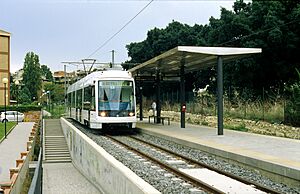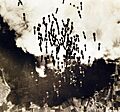Cagliari facts for kids
Quick facts for kids
Cagliari
Casteddu (Sardinian)
|
|||
|---|---|---|---|
| Comune di Cagliari | |||
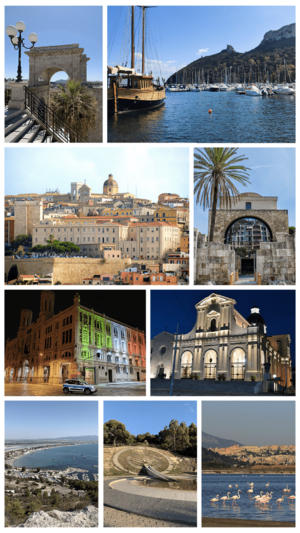
Bastione of Saint Remy; Marina Piccola; View of Castello; Basilica of San Saturnino; City Hall; Basilica of Bonaria; View of the Poetto beach; View of Monte Claro park; View of Molentargius park
|
|||
|
|||
| Country | Italy | ||
| Region | Sardinia | ||
| Area | |||
| • Total | 85.45 km2 (32.99 sq mi) | ||
| Elevation | 4 m (13 ft) | ||
| Population
(2015)
|
|||
| • Total | 154,460 | ||
| • Density | 1,807.61/km2 (4,681.7/sq mi) | ||
| Time zone | UTC+1 (CET) | ||
| • Summer (DST) | UTC+2 (CEST) | ||
| Postal code |
09100
|
||
| Dialing code | 070 | ||
| Patron saint | St. Saturninus | ||
| Saint day | 30 October | ||
Cagliari is an important city in Italy. It is the capital and largest city on the island of Sardinia, which is a special region of Italy. About 155,000 people live in Cagliari itself. If you include the nearby towns, the whole area has about 420,000 people. Cagliari is the biggest city in Sardinia and the 26th largest in Italy.
This ancient city has a very long history, going back about 5,000 years! Many different civilizations have lived here. You can find old buildings and ruins from the Neolithic period, the Carthaginian era, and the Roman Empire. There are also towers from the Pisan era and strong walls built by the Spanish. Cagliari has always been important because of its safe harbor, its hills for defense, and its natural resources like salt and wheat.
Cagliari was once the capital of the Kingdom of Sardinia from 1324 to 1848. Today, it's a major center for culture, education, and art. It's also Sardinia's main economic hub. It has one of the biggest ports in the Mediterranean Sea and an international airport. The city is home to the University of Cagliari, founded in 1607, and has been an important religious center for a very long time.
Contents
Discovering Cagliari's Past
How Cagliari Began
People have lived in the Cagliari area since the Neolithic Age, which was a very long time ago. It was a great place to live because it was near the sea and a fertile plain. There were also marshes for defense and mountains nearby for safety. You can still find traces of these early people, like pottery from the Monte Claro culture and ancient tombs called domus de janas.
Around 800-700 BC, the Phoenicians, who were great sailors and traders, built a colony here called Karaly. They chose this spot because it had an excellent port and was good for trade with Africa. Later, around the late 6th century BC, Carthage took control of Sardinia. Cagliari grew a lot under their rule. You can see this from the large Tuvixeddu necropolis, which is an ancient cemetery.
Cagliari Under Roman Rule
In 238 BC, after the First Punic War, the Romans took over Sardinia and Cagliari. The city, then called Caralis, became a very important Roman naval base and the home of their governor. The Romans built a new part of the city next to the old Punic one. Over time, these two areas grew together.
The Roman writer Florus even called Caralis the "capital of cities" in Sardinia. During the Civil War between Julius Caesar and Pompey, Cagliari was the first city to support Caesar. The Romans built many public buildings, and you can still see the ruins of their amphitheater today.
Cagliari also had one of the earliest Christian communities, with a bishop as early as the 3rd century AD. After the Western Roman Empire fell, Cagliari was ruled by the Vandals and Ostrogoths, and then became part of the Byzantine Empire.
Cagliari's Medieval Kingdoms
During the Middle Ages, Cagliari became the capital of its own independent kingdom called a "Judicate." This kingdom started around 1020 and lasted until 1258. It was a large area, including plains and mountains.
In the 11th century, the city of Pisa in Italy started to become very powerful in Sardinia. Pisa and another Italian city, Genoa, wanted to control Sardinia because it was a great place to manage trade routes between Italy and North Africa.
In 1215, a Pisan leader forced the queen of Cagliari to give him a hill east of the old capital. Soon, Pisan merchants built a new fortified city there called Castel di Castro. This is where modern Cagliari began. In 1258, the Pisans and their allies defeated the last king of Cagliari and destroyed the old capital. Pisa then controlled Castel di Castro.
Some of the strong walls and towers you see in the Castello district today were built by the Pisans. These include the two white limestone towers, the Torre di San Pancrazio and the Torre dell'Elefante.
Spanish and Savoy Rule
In the early 1300s, the Crown of Aragon (from Spain) conquered Sardinia after fighting the Pisans. Cagliari, known as Castel de Càller in Catalan, became the capital of the new Kingdom of Sardinia. This kingdom later became part of the Spanish Empire. Spanish rulers lived in the Palazzo Regio in Cagliari.
The city's defenses were made even stronger in the 16th century. An important university was also founded in Cagliari in the early 1600s.
In 1718, Cagliari and Sardinia came under the rule of the House of Savoy, an Italian royal family. They became the kings of Sardinia. The capital of the kingdom was moved to Turin in 1848, but Cagliari remained very important.
In the late 1700s, during the French Revolutionary Wars, France tried to take Cagliari because it was a key location in the Mediterranean. The French were defeated by the Sardinians who bravely defended their city. The people of Cagliari hoped the Savoys would give them more say in the government, but they refused. This led to an uprising where the people of Cagliari expelled the Savoy rulers for a short time. This event is still celebrated today on Sa die de sa Sardigna (The Day of Sardinia) in late April.
Cagliari in Modern Times
After Italy became a unified country in the late 1800s, Cagliari grew very quickly. Many beautiful buildings were constructed, often in the Art Nouveau style, like the City Hall near the port.
During Second World War, Cagliari was heavily bombed by the Allies in February 1943. Many buildings were damaged, and people had to leave the city for safety. The city was later awarded the Gold Medal of Military Valour for its bravery. After the war, Cagliari rebuilt and continued to grow, with new homes and areas for fun.
Cagliari's Coats of Arms
Exploring Cagliari's Geography
Hills and Landscapes
Cagliari is located in the south of Sardinia, on a beautiful gulf called the "Bay of Angels." The city is built on and around a main hill called Castello, and nine other limestone hills. These hills are unique because they rise about 100 meters (328 feet) above the flat plains around them.
The sea has shaped Cagliari's landscape over time, leaving behind limestone that formed these hills. Castello is where the fortified city was built in the Middle Ages, close to the port. Other hills include Mount Urpinu, the St. Elias hill (also known as the "Saddle of the Devil" because of its shape), and San Michele hill with its castle.
The modern city has grown in the flat areas between these hills and the sea. You can find the Poetto beach, and lagoons like Santa Gilla and Molentargius. From the higher points in the city, you can see amazing views of the bay, the plains, and the mountains that surround Cagliari. On clear winter days, you might even see the snowy peaks of Gennargentu.
City Neighborhoods
Cagliari has four old neighborhoods: Castello, Marina, Stampace, and Villanova. Over time, new districts like San Benedetto and Monte Urpinu have grown as parts of the old city walls were taken down in the 1800s.
Pirri is a town that has become part of Cagliari. It has about 30,000 people and was absorbed into the city as it grew quickly after World War II.
Parks and Green Spaces
Cagliari is known as one of Italy's "greenest" cities. There are many public gardens and parks for everyone to enjoy. The mild climate allows many beautiful subtropical plants to grow here, like the Jacaranda tree with its purple flowers and large Ficus trees that provide shade.
Some of the main parks include:
- Monte Urpinu Park: This is the most wooded park, covered with pine and oak trees. It's about 25 hectares (62 acres) in size.
- Park of San Michele hill: Also about 25 hectares, with a medieval castle on top.
- Terramaini Park: About 13 hectares (32 acres), with a small pond where you can see flamingos and other birds.
- Monte Claro Provincial Park: About 22 hectares (54 acres), home to the provincial library.
- Public gardens: The oldest public park in the city, with lovely Jacaranda trees.
The Molentargius - Saline Regional Park, with its salt ponds, is also very close to the city. You can also find large forests and wildlife, like Sardinian deer, in nearby mountain parks.
Cagliari's Beaches
The main beach in Cagliari is the Poetto. It's about 8 kilometers (5 miles) long and stretches from the Sella del Diavolo hill. Poetto is also the name of the area next to the beach. Another smaller beach is Calamosca, near the Sant'Elia district. Cagliari is also close to other beautiful beaches like Santa Margherita di Pula and Villasimius.
Cagliari's Climate
Cagliari has a warm Mediterranean climate. This means it has hot, dry summers and mild winters. Sometimes in summer, temperatures can go above 40°C (104°F). In winter, it rarely drops below freezing. Heavy snow is very rare, happening only about every thirty years.
The average temperature in January (the coldest month) is about 10°C (50°F), and in August (the warmest month) it's about 25°C (77°F). Rain is rare from mid-June to mid-September. Winds are common, especially the mistral and sirocco.
People and Economy
Population and Growth
In 2014, about 154,356 people lived in Cagliari. The city has more older people than younger people, which is common in many developed countries. About 5.8% of the population in 2020 was from other countries, with the largest groups being Filipinos, Ukrainians, and Romanians.
In 1928, during the fascist era, several nearby towns were combined with Cagliari to make it seem like a bigger city. After World War II, these towns became independent again, except for Pirri.
Metropolitan Area
The Metropolitan City of Cagliari was created in 2016. It includes Cagliari and 16 other nearby towns, with a total population of about 420,000 people. This area covers plains, lagoons, and mountains.
The population in the metropolitan area has grown a lot over the last century, much more than in the rest of Sardinia. This means many people have moved to the Cagliari area, making it a busy center surrounded by less populated rural areas. Most of the economic activities and wealth of Sardinia are found here.
Cagliari's Economy
Cagliari is the administrative center of Sardinia, with many regional and government offices. It's also the main place for business and industry on the island.
The port of Cagliari is very important for moving goods, ranking third in Italy for cargo. It also handles many passengers, including cruise ships. You can find large shopping centers in the metropolitan area with many well-known European stores. Amazon also has a customer service center here.
Many big companies like Coca-Cola, Heineken, and Unilever have factories in the area. One of Europe's largest oil refineries, Saras, is also located nearby.
Tourism is a big part of Cagliari's economy. While the city has many historical sites like medieval walls, Roman ruins, and Byzantine churches, it's also famous for its beautiful beaches. Cruise ships often stop in Cagliari, and it's a great starting point to visit nearby beaches like Villasimius and Chia. The city has many hotels, B&Bs, and places for young people and tourists to enjoy.
Top Sights in Cagliari
Ancient Wonders and Churches
You can still see many parts of the ancient city of Karalis. These include the Tuvixeddu necropolis, which is the largest ancient Punic cemetery, and the Roman amphitheater, sometimes called "One hundred steps." There are also old water systems and tombs.
The ancient Christian church of San Saturnino, dedicated to the city's patron saint, was built in the 5th century. Another old church, San Lucifero, has a crypt from early Christian times.
The old medieval town, called Castello (meaning "castle" in Italian), sits on top of a hill with amazing views of the Gulf of Cagliari. Most of its city walls are still standing. You can see two tall, white limestone towers from the early 1300s: the Torre di San Pancrazio and the Torre dell'Elefante. These were built by the Pisans.
The famous writer D. H. Lawrence visited Cagliari in 1921 and described it as a "white Jerusalem" because of its bright white limestone buildings in the Mediterranean sun.
The cathedral was rebuilt in the 1930s to look more like its original medieval Pisan style. It has a beautiful bell tower and a special pulpit carved in the 1100s. The crypt inside holds the remains of martyrs.
The Sanctuary of Our Lady of Bonaria was built by the Catalans in the 1320s. It has a small Gothic entrance, and inside, there's a wooden statue of the Madonna that, according to legend, floated to shore after being thrown from a Spanish ship. The Monumental Cemetery of Bonaria is also on this hill.
Historic Districts and Modern Buildings
The old districts of Marina, Stampace, and Villanova still have their original charm. In Stampace, you can find the Torre dello Sperone, another tower built by the Pisans. There are also two important Baroque-style churches from the 1700s: the Collegiata di Sant'Anna and the Chiesa di San Michele.
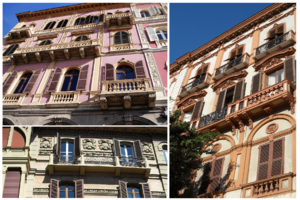
The Promenade Deck and the Terrazza Umberto I were designed in the late 1800s. They are made of white and yellow limestone with classical columns. This area was damaged during World War II but was rebuilt. It's now used for cultural events and art exhibitions.
Modern parts of Cagliari, built in the late 1800s and early 1900s, feature Art Deco and Fascist-era architecture, like the Court of Justice. This building is near Monte Urpinu, the city's largest park. The University Botanical Gardens are also a great place to visit.
Cagliari's Culture and Arts
Libraries and Literature
Cagliari has many libraries, including the old University Library with thousands of ancient books. The State Archive holds historical documents from the 1300s to today.
The history of Sardinian literature began in Cagliari. In the 1st century AD, poems were carved into a tomb in the Tuvixeddu necropolis. Later, in the 4th century, Bishop Lucifer of Cagliari wrote important texts. Many writers have described life in Cagliari, including the famous D.H. Lawrence in his book Sea and Sardinia. Modern writers like Sergio Atzeni have set their stories in the city.
Music and Theater
Cagliari is the birthplace of famous artists like film director Nanni Loy and actors Amedeo Nazzari and Pier Angeli.
The city's first theater, the Teatro Zapata, opened in 1767. It was damaged in 1943 but has been restored and is now an open-air theater. In 1993, a new opera house, the Teatro Lirico, was opened. Cagliari has also been home to many talented opera singers. The Italian pop singer Marco Carta was born here.
There are also active comedy and satirical theater groups in the city. Cagliari is home to the Centro Internazionale del Fumetto (Comic Strip International Centre), which created popular comic characters like Nathan Never.
Museums and Galleries
The "Citadel of Museums" in Cagliari is a great place to explore. It includes:
- National Archeological Museum of Cagliari: The most important archeological museum in Sardinia, with items from 6000 BC to 1000 AD.
- Civic Siamese Art Museum "Stefano Cardu": A unique collection of Siamese art from the early 1900s.
- Anatomical Waxwork Museum "Clemente Susini": One of the best collections of anatomical waxworks in the world, showing how the human body was understood in the early 1800s.
- Civic Art Gallery: Features modern Italian and Sardinian art.
- University Botanical Gardens: A beautiful botanical garden.
Other museums include the Bonaria Museum, the Cathedral Museum, and the Treasure Museum of Saint Eulalia.
Feast of Sant'Efis
The Feast of St. Ephysius is Cagliari's most important religious event, held every year on May 1st. Thousands of people from all over Sardinia wear their traditional costumes. The saint is carried in a long procession to Nora, about 35 kilometers (22 miles) from Cagliari, where he was martyred. This is one of the oldest and longest religious processions in Italy.
The tradition started in 1656. A terrible plague was spreading in Sardinia, especially in Cagliari. Legend says that St. Ephysius appeared to the Spanish ruler and asked for a procession on May 1st to stop the plague. The city promised to hold the procession every year if the plague ended. It did, and the festival has been held ever since!
Other Events
Other fun events in Cagliari include Carnival, Holy Week and Easter celebrations, and sea processions in May and July. The Cagliari Fair is also held in early May.
Languages of Cagliari
The traditional language of Cagliari, along with Italian, is Sardinian (specifically the Campidanese dialect). This local language has been important for writers and poets. However, younger generations in the city mostly speak Italian, as it's used in schools and media.
Cagliari's Food
Cagliari has special food traditions, different from the rest of Sardinia. Its cuisine mostly uses the many kinds of seafood available locally. You can find influences from Spanish and Sicilian food, but Cagliari's dishes have their own unique taste.
Delicious wines are also part of meals in Cagliari, like Cannonau, Nuragus, and Monica. These are made in the vineyards of the nearby Campidano plain.
Sports and Education
Sports in Cagliari
Cagliari is home to the football (soccer) team Cagliari Calcio, which won the Italian league championship in 1970. The team plays at the Unipol Domus stadium.
Cagliari is also a great place for water sports like surfing, kitesurfing, windsurfing, and sailing because of its strong, steady winds. Field hockey is also popular, with two local teams playing in Italy's top league.
The city has many sports venues, including the Unipol Domus, tennis clubs, swimming pools, and athletics stadiums.
Learning in Cagliari
Cagliari is home to the University of Cagliari, the largest public university in Sardinia. It was founded in 1626 and has about 35,000 students. It offers many different subjects, from engineering and medicine to economics and humanities. Many of the science departments and the university hospital are located in a new "University Citadel" in Monserrato.
Cagliari also has a Pontifical Faculty of Theology and the European Institute of Design.
Getting Around Cagliari
Airport and Roads
The city is served by the Cagliari-Elmas International Airport, just a few kilometers from the city center. It's one of the busiest airports in Italy. A train line connects the airport to the city, and there are also bus services.
Several main roads start in Cagliari, connecting it to other parts of Sardinia.
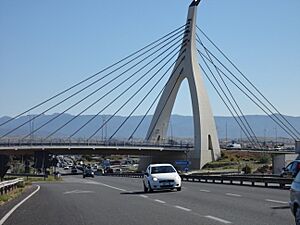
Ports and Railways
The port of Cagliari is very important for cargo and passenger ships. It's the third busiest port in Italy for freight. You can take passenger ships from Cagliari to other Italian cities like Civitavecchia, Naples, and Palermo. There are also smaller ports for tourist boats.
The main train station in Cagliari has services to many towns across Sardinia, including Iglesias, Olbia, and Sassari. There's also a special narrow-gauge train line from nearby Monserrato.
City Transport
Cagliari has a good public transport system with buses and trolleybuses. It's one of the few Italian cities with a large trolleybus network. There's also a tram service called MetroCagliari that connects different parts of the city, including the university campus. A public bike-sharing service is also available.
Cagliari's Global Connections
Sister Cities
Cagliari is "twinned" with several cities around the world, meaning they have special friendly relationships. These include:
 Buenos Aires, Argentina
Buenos Aires, Argentina Nanyuki, Kenya
Nanyuki, Kenya Pisa, Italy
Pisa, Italy Vercelli, Italy
Vercelli, Italy Turin, Italy
Turin, Italy Padua, Italy
Padua, Italy Biella, Italy
Biella, Italy
Consulates in Cagliari
Many countries have consulates in Cagliari to help their citizens and promote relations. Some of these include:
Images for kids
-
Bombs from a B-17 Flying Fortress falling on Monserrato Airfield near Cagliari, 1943
See also
 In Spanish: Cagliari para niños
In Spanish: Cagliari para niños




